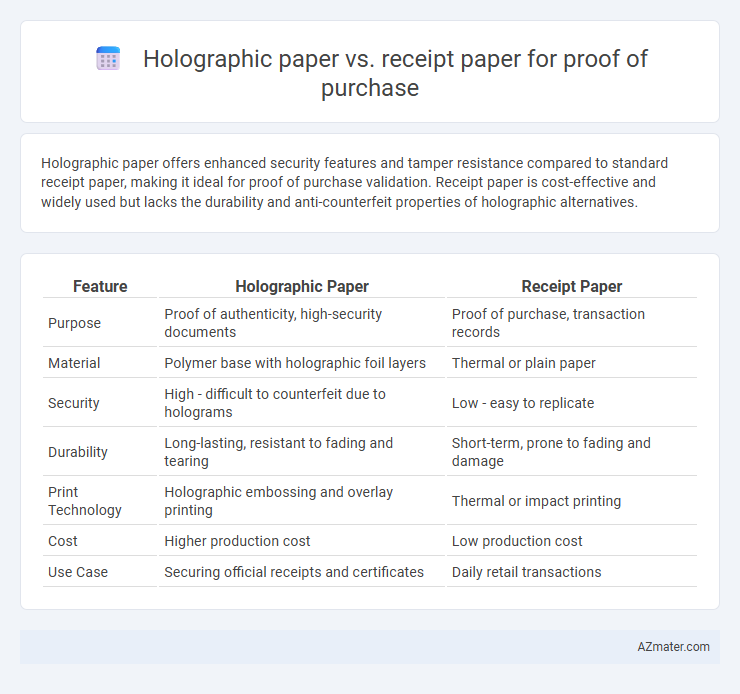Holographic paper offers enhanced security features and tamper resistance compared to standard receipt paper, making it ideal for proof of purchase validation. Receipt paper is cost-effective and widely used but lacks the durability and anti-counterfeit properties of holographic alternatives.
Table of Comparison
| Feature | Holographic Paper | Receipt Paper |
|---|---|---|
| Purpose | Proof of authenticity, high-security documents | Proof of purchase, transaction records |
| Material | Polymer base with holographic foil layers | Thermal or plain paper |
| Security | High - difficult to counterfeit due to holograms | Low - easy to replicate |
| Durability | Long-lasting, resistant to fading and tearing | Short-term, prone to fading and damage |
| Print Technology | Holographic embossing and overlay printing | Thermal or impact printing |
| Cost | Higher production cost | Low production cost |
| Use Case | Securing official receipts and certificates | Daily retail transactions |
Introduction to Proof of Purchase Methods
Proof of purchase methods often utilize holographic paper and receipt paper to ensure transaction authenticity and prevent fraud. Holographic paper incorporates unique, difficult-to-replicate visual elements that enhance security and brand protection, making it ideal for high-value or sensitive purchases. Receipt paper, typically thermal or bond paper, provides a cost-effective and widely used solution for documenting sales with printed transaction details and timestamps essential for customer returns and warranty claims.
What is Holographic Paper?
Holographic paper is a specialized material embedded with a three-dimensional, reflective surface that creates a unique visual effect, often used to prevent fraud and enhance security in proof of purchase documents. Unlike standard receipt paper, which is typically thermal or plain paper designed for temporary use, holographic paper incorporates microstructures that diffract light, making it difficult to replicate or counterfeit. This security feature makes holographic paper an ideal choice for official receipts, certificates, and other proof of purchase documents requiring authentication and durability.
What is Receipt Paper?
Receipt paper is a thermal or plain paper commonly used in point-of-sale systems to provide customers with printed proof of purchase, recording transaction details such as date, time, items bought, and total cost. It is designed for quick printing, cost-effectiveness, and legibility but lacks advanced security features found in holographic paper, making it more susceptible to tampering or forgery. Receipt paper remains essential in retail environments for documentation and customer service despite its vulnerabilities compared to holographic alternatives.
Security Features: Holographic vs. Traditional Receipt Paper
Holographic paper offers enhanced security features such as tamper-evident holograms, multi-layered designs, and reflective qualities that prevent counterfeiting and forgery, making it superior for proof of purchase validation. Traditional receipt paper, typically thermal or plain paper, lacks these advanced security elements and is more susceptible to fraudulent alterations or duplication. Businesses aiming to reduce fraud and ensure document authenticity benefit from the sophisticated protection provided by holographic paper over standard receipt paper.
Durability Comparison: Longevity and Fading
Holographic paper exhibits superior durability compared to standard receipt paper, offering enhanced resistance to fading and wear over time. Its multi-layered construction with embedded holograms protects against environmental factors such as UV exposure and moisture, ensuring proof of purchase remains legible for extended periods. Receipt paper, typically thermal-based, is prone to rapid fading due to heat and light, limiting its longevity to just a few months under normal conditions.
Cost Implications of Holographic and Receipt Papers
Holographic paper generally incurs higher costs due to its advanced security features and complex manufacturing process, making it suitable for high-value proof of purchase documents where fraud prevention is critical. Receipt paper, typically thermal or plain paper, offers a low-cost alternative with minimal security, ideal for everyday transactions but susceptible to tampering and fading over time. Businesses must weigh the upfront expense of holographic paper against potential losses from counterfeit or disputed purchases associated with receipt paper.
Ease of Verification for Retailers and Consumers
Holographic paper enhances ease of verification for retailers and consumers by providing a distinct visual security feature that is difficult to replicate, enabling quick and reliable authenticity checks. Receipt paper relies primarily on printed information, which can be more easily forged and often requires additional verification tools or digital systems. The integration of holographic elements reduces transaction times and increases confidence in proof of purchase authenticity, benefiting both parties in retail environments.
Environmental Impact: Sustainability and Recycling
Holographic paper typically contains metallic and plastic elements that complicate recycling processes and increase environmental impact compared to standard receipt paper, which is usually made from thermal paper or recycled materials designed for easier disposal. Thermal receipt paper often contains BPA or BPS chemicals, raising sustainability concerns despite being more recyclable than holographic variants. Opting for paper certified by environmental standards such as FSC or using digital receipts can further reduce the ecological footprint associated with proof of purchase documentation.
Fraud Prevention: Effectiveness in Counterfeit Protection
Holographic paper offers superior fraud prevention compared to standard receipt paper by incorporating complex, difficult-to-replicate security features such as multi-layered holograms and microtext, deterring counterfeit attempts. Receipt paper, typically lacking these security elements, remains more vulnerable to forgery and tampering due to its simple printing technology. In environments requiring enhanced counterfeit protection, holographic paper significantly increases the authenticity verification process, reducing the risk of fraudulent proof of purchase.
Future Trends in Proof of Purchase Technology
Holographic paper enhances proof of purchase security by integrating advanced anti-counterfeiting features, while receipt paper continues to evolve with digital receipts and QR codes for seamless verification. Future trends emphasize the fusion of physical and digital technologies, such as blockchain-enabled holographic labels and smart receipt paper with embedded NFC tags that ensure authenticity and real-time tracking. These innovations aim to combat fraud and provide consumers and businesses with efficient and tamper-proof proof of purchase solutions.

Infographic: Holographic paper vs Receipt paper for Proof of purchase
 azmater.com
azmater.com